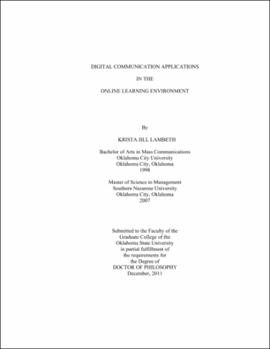| dc.contributor.advisor | Castle, Kathryn | |
| dc.contributor.author | Lambeth, Krista Jill | |
| dc.date.accessioned | 2013-11-26T08:34:39Z | |
| dc.date.available | 2013-11-26T08:34:39Z | |
| dc.date.issued | 2011-12 | |
| dc.identifier.uri | https://hdl.handle.net/11244/7472 | |
| dc.description.abstract | Scope and Method of Study: The purpose of this study was for the researcher to obtain a better understanding of the online learning environment, to explore the various ways online class instructors have incorporated digital communication applications to try and provide learner-centered online learning environments, and to examine students' perceptions of the use of digital communication applications in achieving learning outcomes. The study consisted of four online courses where the online class instructors used various types of digital communication applications including: Wimba, GoogleTalk, VoiceThread, online content videos, instructor-made videos, avatars, Skype, a Blog and a digital workbook in order to try and create learner-centered online learning environments. The study consisted of interviewing the four online class instructors and five online students, observing nine online students use of the applications in the four online courses, electronic journaling, observations and reviewing the online courses' artifacts. | |
| dc.description.abstract | Findings and Conclusions: In answering the research questions various categories began to emerge. The common categories for the functions of digital communication applications were to create instructor-to-student interaction, student-to-content interaction, and student-to-student interaction. The common categories for online class instructors determining which types of digital communication applications to incorporate into their online courses were course objectives, online class instructors' past experiences with the use of the application, and students' past learning experience with the application. The common categories for students' perceptions of digital communication applications in online courses were students preferred the use of traditional forms of communication over digital communication applications when both options were available, students were more inclined to use a digital communication application if a grade was assigned as part of the participation, students believed the use of online content videos and instructor-made videos were the most effective types of applications in the learning process and students' perceptions did not differ between novice and veteran students. The various categories indicated that although online class instructors incorporate different types of digital communication applications in order to create various types of interactions in the online learning environment, students' use of most types of digital communication applications did not assist students in being active participants in the learning process. | |
| dc.format | application/pdf | |
| dc.language | en_US | |
| dc.rights | Copyright is held by the author who has granted the Oklahoma State University Library the non-exclusive right to share this material in its institutional repository. Contact Digital Library Services at lib-dls@okstate.edu or 405-744-9161 for the permission policy on the use, reproduction or distribution of this material. | |
| dc.title | Digital communication applications in the online learning environments | |
| dc.contributor.committeeMember | Brown, Pamela | |
| dc.contributor.committeeMember | Wang, Hongyu | |
| dc.contributor.committeeMember | Harris, Edward | |
| osu.filename | Lambeth_okstate_0664D_11801 | |
| osu.accesstype | Open Access | |
| dc.type.genre | Dissertation | |
| dc.type.material | Text | |
| dc.subject.keywords | online learning | |
| dc.subject.keywords | education | |
| thesis.degree.discipline | Curriculum Studies | |
| thesis.degree.grantor | Oklahoma State University | |
